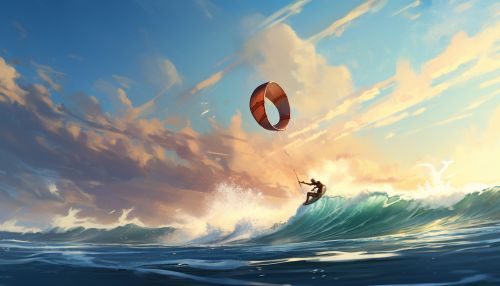Kitesurfing
History
Kitesurfing, also known as kiteboarding, is a surface water sport that combines elements of wakeboarding, windsurfing, surfing, paragliding, and sailing. It emerged in the late 20th century as a result of technological advancements in material and design. The sport has its roots in the use of kites for propulsion, which dates back to the 13th century in China. The modern form of kitesurfing began to take shape in the late 1970s and early 1980s, with various inventors and sports enthusiasts experimenting with kites and boards.


Equipment
The primary equipment used in kitesurfing includes a kite, a board, a harness, and a control bar. The kite, which is the driving force, is designed to be aerodynamic and is controlled by the rider through the control bar. The board, similar to a small surfboard or wakeboard, is ridden by the kitesurfer and is used to glide across the water. The harness attaches the rider to the kite and helps distribute the force of the kite's pull.
Kite
The kite used in kitesurfing is a large, inflatable structure that is designed to catch the wind and provide propulsion. There are several types of kites used in kitesurfing, including leading edge inflatable (LEI) kites, foil kites, and light wind kites. Each type of kite has its own characteristics and is suited to different conditions and styles of kitesurfing.
Board
The board used in kitesurfing is typically a small, lightweight structure with foot straps or bindings. There are several types of boards used in kitesurfing, including twin-tip boards, directional boards, and hydrofoil boards. Twin-tip boards are the most common and are versatile and easy to use. Directional boards are similar to surfboards and are used in wave riding. Hydrofoil boards are used for racing and in light wind conditions.
Harness
The harness used in kitesurfing is a device that is worn by the rider and is used to connect the rider to the kite. The harness helps distribute the force of the kite's pull across the rider's body, reducing strain and allowing the rider to control the kite with less effort. There are two types of harnesses used in kitesurfing: waist harnesses and seat harnesses.
Control Bar
The control bar used in kitesurfing is a device that is used to control the kite. The control bar is connected to the kite by lines and is used to steer the kite and control its power. The control bar also includes a safety release system that allows the rider to quickly detach from the kite in case of emergency.
Techniques
There are several techniques used in kitesurfing, including launching, landing, jumping, and wave riding. Launching is the process of getting the kite into the air and starting to ride. Landing is the process of bringing the kite down and stopping the ride. Jumping involves using the kite to lift off the water and perform aerial maneuvers. Wave riding involves using the kite to ride waves, similar to surfing.
Safety
Safety is a critical aspect of kitesurfing. The sport involves high speeds and powerful forces, and accidents can result in serious injury or death. Safety measures in kitesurfing include the use of safety equipment, adherence to rules and regulations, and proper training and instruction.
Competitions
Competitions in kitesurfing are held around the world and include events such as races, freestyle competitions, and wave riding competitions. The World Kiteboarding Championships is the premier international competition in the sport.
